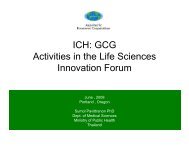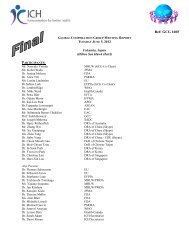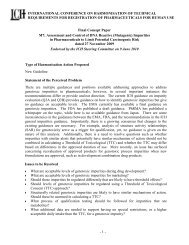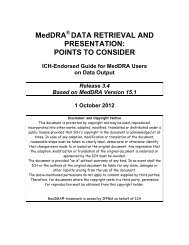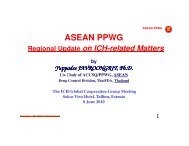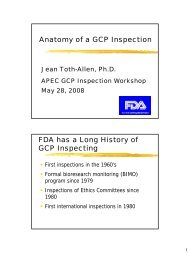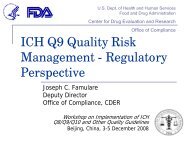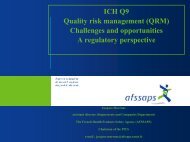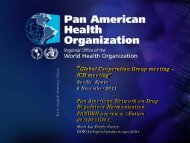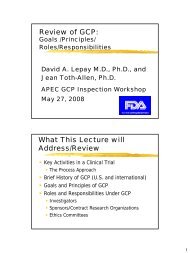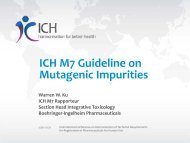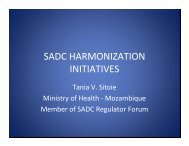Final Business Plan Q3D: Impurities: Guideline for Elemental ... - ICH
Final Business Plan Q3D: Impurities: Guideline for Elemental ... - ICH
Final Business Plan Q3D: Impurities: Guideline for Elemental ... - ICH
You also want an ePaper? Increase the reach of your titles
YUMPU automatically turns print PDFs into web optimized ePapers that Google loves.
<strong>Final</strong> <strong>Business</strong> <strong>Plan</strong><br />
<strong>Q3D</strong>: <strong>Impurities</strong>: <strong>Guideline</strong> <strong>for</strong> <strong>Elemental</strong> <strong>Impurities</strong><br />
Dated 17 July 2009<br />
Endorsed by the Steering Committee on 29 October 2009<br />
The Issue and its Costs<br />
There is currently no harmonised guidance to assure appropriate control of metal impurities<br />
in drug products and ingredients. The <strong>ICH</strong> Q3A <strong>Guideline</strong> classifies impurities as organic,<br />
inorganic, and residual solvents. Whereas organic impurities and residual solvents are<br />
appropriately addressed in <strong>ICH</strong> <strong>Guideline</strong>s, inorganic impurities are not. Only the following<br />
in<strong>for</strong>mation regarding inorganic impurities is provided in the <strong>ICH</strong> Q3A <strong>Guideline</strong>:<br />
"Inorganic impurities are normally detected and quantified using pharmacopoeial or<br />
other appropriate procedures. Carry-over of catalysts to the new drug substance should<br />
be evaluated during development. The need <strong>for</strong> inclusion or exclusion of inorganic<br />
impurities in the new drug substance specification should be discussed. Acceptance<br />
criteria should be based on pharmacopoeial standards or known safety data."<br />
There are significant issues that arise from this limited guidance as listed below:<br />
• The current pharmacopoeial procedures to control inorganic impurities include the<br />
Heavy Metals test, Residue on Ignition/Sulphated Ash, and other wet-chemistry tests.<br />
While these tests <strong>for</strong> inorganic impurities may be suitable in certain cases, the<br />
procedures also have some deficiencies: they may be non-specific and were not<br />
developed to detect low-level residual metal catalysts and reagents which may be used<br />
in modern synthetic processes. The Heavy Metals test in particular is often used <strong>for</strong><br />
broad screening of potential metal impurities, without appropriate consideration of a<br />
risk-based approach to control metals that are likely to be present.<br />
• The acceptance criteria provided in pharmacopoeial standards are based on historical<br />
precedent and not necessarily on appropriate safety data. The number of metals<br />
which are actually detected by the usual pharmacopoeial procedures, especially the<br />
Heavy Metals test, is limited and does not include many of the metals which have the<br />
greatest toxicological concern.<br />
The current reliance on pharmacopoeial standards to control inorganic impurities presents<br />
other significant issues. The analytical procedures and acceptance criteria in the<br />
pharmacopoeias may be provided in general chapters and specific monographs <strong>for</strong> excipients,<br />
drug substances, and drug products. While general chapters and excipient monographs are<br />
currently in the scope of PDG harmonisation, drug substance and product monographs are<br />
not. Some of the general chapters <strong>for</strong> inorganic impurities are included in the PDG work<br />
programme <strong>for</strong> harmonisation, but others are not. Even <strong>for</strong> general chapters that are being<br />
considered by PDG <strong>for</strong> harmonisation, the fundamental approaches taken by the various<br />
pharmacopoeias are not always consistent, making the likelihood of a harmonised outcome<br />
unlikely. The overall result is inconsistency in the general analytical procedures and specific<br />
International Conference on Harmonisation of Technical Requirements <strong>for</strong> Registration of Pharmaceuticals <strong>for</strong> Human Use<br />
<strong>ICH</strong> Secretariat, Chemin Louis-Dunant 15, P.O. Box 195, 1211 Geneva 20, Switzerland<br />
Telephone: +41 (22) 338 32 06, Telefax: +41 (22) 338 32 30<br />
admin@ich.org, http://www.ich.org
FINAL <strong>Q3D</strong> EWG <strong>Business</strong> <strong>Plan</strong> Endorsed: 29 October 2009<br />
acceptance criteria <strong>for</strong> controlling metal impurities in drug products and ingredients, with<br />
insufficient control <strong>for</strong> those metals with the highest associated safety risk to patients.<br />
The challenges associated with non-harmonised pharmacopoeial standards <strong>for</strong> inorganic<br />
impurities are exacerbated when consideration is given to the lack of harmonised regulatory<br />
guidance in this area. While guidance on specification limits <strong>for</strong> residues of metal catalysts<br />
and reagents was recently provided by EMA, similar regulatory guidance has not yet been<br />
provided from the US or Japan <strong>for</strong> public review. Additionally, due to its scope, the EMA<br />
guidance does not address several metals posing significant toxicological concerns, in<br />
particular lead, mercury, arsenic, and cadmium. <strong>Final</strong>ly, upon review of recently published<br />
proposals from USP <strong>for</strong> possible revision to their Heavy Metals test, the possible divergence<br />
in approach and acceptance criteria among the three major pharmacopoeias and from the<br />
EMA regulatory guidance emerged as a possible outcome.<br />
While the current lack of clear and consistent guidance <strong>for</strong> the control of inorganic impurities<br />
is very problematic <strong>for</strong> the pharmaceutical industry, the primary concern is ensuring the<br />
safety of the patient. A harmonised <strong>ICH</strong> <strong>Guideline</strong> to address inorganic impurities, and<br />
specifically metal impurities, will help ensure appropriate control <strong>for</strong> these impurities, to the<br />
benefit of public health. The <strong>ICH</strong> <strong>Guideline</strong> will ensure that new requirements have the<br />
necessary input of the regional regulatory authorities to help protect patient safety, and should<br />
also help to avoid differing approaches and standards among the pharmacopoeias and the<br />
regulators. This consistency will avoid current redundant testing to meet different<br />
requirements, and will make the implementation of the harmonised outcomes more readily<br />
achievable by the pharmaceutical industry.<br />
Financial Costs<br />
Focusing on the Heavy Metals test, the costs associated with the lack of pharmacopoeial<br />
harmonisation may be summarised as follows: per<strong>for</strong>ming each individual test requires about<br />
3-4 personnel-hours (estimate <strong>for</strong> a pharmaceutical manufacturer laboratory) or around $200-<br />
$600 (cost <strong>for</strong> contract laboratory testing), depending on the particular procedure and sample.<br />
Having to per<strong>for</strong>m 3 different methods instead of 1 harmonised method thus results in<br />
additional costs of 6-8 hours or $400-$1200 per sample. This cost is greatly magnified when<br />
considering the significant number of compendial monographs which contain the test<br />
requirement <strong>for</strong> Heavy Metals (around 700-900 individual monographs in each of the USP,<br />
Ph. Eur., and JP), as well as the large number of lots of API and excipient which are<br />
manufactured or received and tested <strong>for</strong> use by pharmaceutical companies.<br />
Additional cost considerations would result from the recent USP proposal to replace the wet<br />
chemical Heavy Metals test with an instrumental procedure (AA, ICP-OES, or ICPMS) <strong>for</strong><br />
use in broad screening <strong>for</strong> metal contamination. These instruments may cost from around<br />
$60,000 <strong>for</strong> AA to $100,000 <strong>for</strong> ICP-OES and up to $200,000 <strong>for</strong> ICP-MS. Further costs<br />
associated with these instruments include maintenance (service contracts are estimated to cost<br />
around 10% of the instrument purchase price per year), analyst training, materials, chemicals<br />
(e.g., argon gas <strong>for</strong> ICP) and reference standards.<br />
<strong>Plan</strong>ning<br />
The expected deliverables are as follows:<br />
• Harmonised, safety-based limits <strong>for</strong> metal impurities, especially those with highest<br />
toxicological concerns.<br />
2
FINAL <strong>Q3D</strong> EWG <strong>Business</strong> <strong>Plan</strong> Endorsed: 29 October 2009<br />
• Appropriate risk-based approach to ensure control <strong>for</strong> metals likely to be present in<br />
drug products and ingredients, including those resulting from the manufacturing<br />
process (metal catalysts and reagents), as well as those due to the material source<br />
(e.g., Pb, Hg, As, Cd).<br />
• Note: The new guideline would focus on the establishment of appropriate limits <strong>for</strong><br />
specific metals, without necessarily providing details on the analytical procedures to<br />
be used; harmonised analytical procedures should be established by the<br />
pharmacopoeias <strong>for</strong> determining levels of metal impurities, with allowance <strong>for</strong> use of<br />
any appropriate validated procedure <strong>for</strong> a particular application.<br />
The following resources would be required:<br />
• <strong>ICH</strong> EWG including chemists (with backgrounds in QA and R&D) along with<br />
toxicologists.<br />
The following points may be considered <strong>for</strong> the project time-frame:<br />
• The ability to start with the EMA guideline on metal impurities, which was structured<br />
in a manner similar to the <strong>ICH</strong> Q3C <strong>Guideline</strong> <strong>for</strong> residual solvents, should make it<br />
feasible to develop the proposed guideline within one to two years of initiation of the<br />
work.<br />
Key milestones include:<br />
• Metals: Selection of specific metals to control.<br />
• Approach: Selection of approach/methodology/rationale to be used <strong>for</strong> establishing<br />
safety-based limits.<br />
• Limits: Agreement on individual limits <strong>for</strong> specific metals.<br />
The Impacts of the Project<br />
The likely benefits resulting from the fulfilment of the objective include:<br />
• A consistent approach to ensure patient safety regarding metal impurities.<br />
• Elimination of redundant, non-harmonised testing <strong>for</strong> industry.<br />
• A harmonised guideline to facilitate regulatory implementation <strong>for</strong> review of product<br />
registrations, inspections, and surveillance testing related to metal impurities.<br />
Post-hoc Evaluation<br />
The results of the work will be evaluated as follows:<br />
• Increased efficiency in product testing (cost savings to industry).<br />
• Increased efficiency in regulatory review (cost savings to regulators).<br />
3




